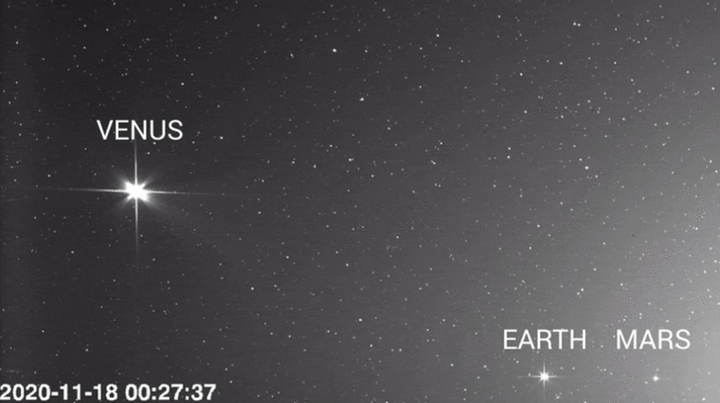The European Space Agency reported that on November 18, 2020, the Solar Orbiter managed to catch three out of the eight planets in our solar system in just one frame. The resulting four-second video was stitched together over 22 hours from a collection of still photographs taken.

Venus is the brightest and largest of the elements, preceded to the lower right of the picture by Earth and then Mars. What's incredibly cool about this perspective is that when it moves away from the Sun and into Venus, the device looks out into the solar system.
The Solar Orbiter has been 48 million km away from Venus, 251 million km from Earth, and 332 million km from Mars when it took the photo. To the lower right, the Sun is out of frame, but its light is clearly noticeable.
In collaboration with NASA and the European Space Agency, the spacecraft headed straight to Venus for gravitational assistance when Heliospheric Imager (SoloHI) took the photo.
As the spaceship was on its way to Venus, it turned its cameras toward Earth during its mission. Venus, and Mars while the three planets appeared peacefully, surrounded by shimmering stars, in the depths of space.
Context
The Solar Orbiter is a NASA-European Space Agency collaboration (ESA). The aim is to address some of the unanswered, basic concerns that scientists have about the Sun. What powers solar winds? Why does the electric force of the Sun impact solar activity? And how can a star affect the Solar System, our own world included?
The Solar Orbiter, launched in February 2020 and fitted with 10 separate instruments, is a mission to observe the Sun from close up. Last July, the nearest photographs ever taken of the Sun revealed previously unseen "campfires" on the surface of our star. It uncovered solar mechanisms that were still potentially thought of.
The probe is still observing factors, including the solar wind, or cosmic rays, pouring out into space from the planet in its immediate surroundings. The resulting data will help scientists forecast inclement space weather that can disrupt Earth's communications and infrastructure.
It would take around two years for the spacecraft to hit its goal vantage point on the Sun, utilizing gravitational boosts from Earth and Venus flybys to make the trip.
What Is So Unique?
The video was taken on November 18, when the Solar Orbiter moved closer to Venus.
Venus shines as the brightest planet in the video and can be seen on the west, while Earth is in the center, and on the far right, Mars can be seen. We learn from this standpoint how insignificant we really are relative to the enormous universe.
As the nearest planet to the Sun, the video was taken at the time. Venus was around 48 million kilometers away from the Solar Orbiter, while Earth was 251 million kilometers away. Mars was 332 million kilometers away.
The three planets are overshadowed by stars sparkling in the background, and when the spaceship moves into deep space, they start to pass.
It also appears that the three planets are shifting slightly, each concerning the pace and motion of their orbit around the Earth. To perform one rotation around the Planet, Venus requires 225 days, while the world takes 365 days, and Mars takes 687 days.
Check out more news and information on Space on Science Times.
© 2025 ScienceTimes.com All rights reserved. Do not reproduce without permission. The window to the world of Science Times.












